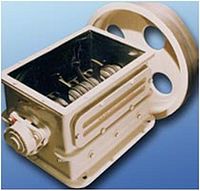Cam Crushers
Cam Crushers are used for crushing soft to medium-hard materials to a relatively uniform particle size according to the gap width of the installed crushing grate.
Features
- Gap width 12 mm or 18 mm.
- Machine housing in solid cast design with top and bottom assembly flange.
- Large cover on the side of the housing for cleaning or removal of tramp material.
Working Principles
Cam crushers operate in the most severe conditions, at high temperature and with very abrasive materials. The crushers are also designed to handle the broadest possible range of materials; as material is discharged from the hopper, the rotating cam teeth shear and split chunks of material against an anvil plate. The anvil plate acts to produce perpendicular forces at all angles of contact between the cams, material and plate. The crushed material then drops through the crusher into a receptacle or conveying line.
From a constructive point of view, the crusher housing is constructed with plates of welded iron, which can be dismounted into several parts. The roller consists of a rotary shaft on which are mounted, in a concentrical way, the crusher cam wheels; these are equipped with teeth with a quadratic section which offer the largest and most efficient crusher surface. The crusher plate is located to produce upright forces at each angle where there is contact between the cam wheels, the material and the plate, and is thus assuring a valid functioning of the crusher until this contact is made.
The cam wheels and the crusher plate are constructed with a special chrome alloy treated to assure a long operational life (600 - 700 HB).
The cam wheels are packed on the shaft with a self regulating spring, on which no maintenance or adjustments have to be executed, and which also has a tensioning function. The shaft is being externally sustained at the housing with supports equipped with spring lubricators which also improve the seal and at the same time reduce the wear of the shaft. The driving group consists of and electrical motor and a reduction gear, connected with an elastic joint. The movement is being transmitted from the shaft to the toothed roller with a power chain. The clearance between the roller and the anvil plate are adjustable in order to allow the change of the outlet maximum size. Safety guards and other proper devices are provided for the exposed moving parts.
Benefits
- Chrome alloy or Cast-in Tungsten Carbide Cams.
- Chrome alloy Anvil Plate or Anvil plate with Solid Tungsten Carbide Teeth.
- Corrosion-resistant internal Components.
- Shaft/Cam Support One-Piece Construction.
- Feed size: up to 1,200 mm in size.
- Product sized to: typical products are (depending from the model) 80 mm, 50 mm, 40 mm, max. size down, depending on feed size.
- Throughput: from as low as 1 TPH up to over 100 TPH, depending on material, feed size and product size.
